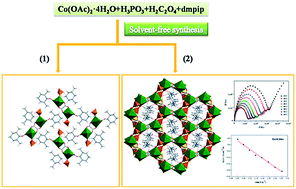Solvent-free synthesis and room temperature proton conductivity of new cobalt phosphite–oxalates†
Abstract
Two new cobalt phosphite–oxalates, formulated as Co2(H2PO3)2(C2O4)3(C6N2H16)2 (1) and Co2(H2PO3)2(C2O4)2(C6N2H16) (2), have been synthesized under solvent-free conditions. Single-crystal X-ray diffraction analysis reveals that compound 1 has a 1D chain-like structure decorated with phosphite groups. It is noted that there are two coordination modes of oxalate ligands in the structure. Compound 2 is a 2D distorted honeycomb-like layered open-framework structure with 12-membered ring windows. Notably, compound 2 possesses room temperature proton conductivity. Extensive hydrogen bonds existing between the host framework and guest part play an important role as proton-conducting pathways.



 Please wait while we load your content...
Please wait while we load your content...